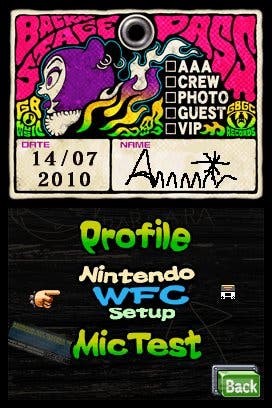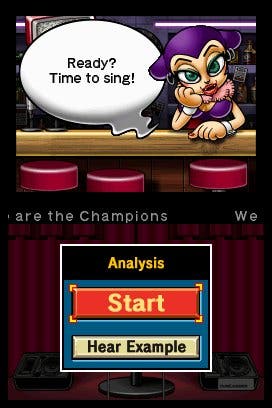Jam with the Band
Melody maker.
Nintendo of Europe has received plenty of stick in the past over interminable delays to PAL releases and other titles never getting a release on these shores. In recent years, things have changed a bit: we got Mario Kart Wii a day after Japan and two weeks before anyone else in the world. US gamers, meanwhile, harrumph in Reggie Fils-Aime's general direction over the non-appearance of niche titles like Disaster: Day of Crisis and Another Code: R.
But even by NOE's recent standards, the sudden reappearance of rhythm-actioner Jam with the Band after five years in the gaming wilderness is a genuine surprise. Originally set for a western release during the DS' launch window way back in 2005 - and demonstrated enthusiastically by Nintendo at the time - the game, known in Japan as Daigasso! Band Brothers, wound up playing only to a home crowd.
Packaged with a set of cheap, tinny earphones, it was a minor hit in the East, and was eventually succeeded by the DX version three years later, which has since gone on to shift over half a million units. As it's this version Jam with the Band is based on, pedants may wish to note that we've technically only had to wait a little under two years, the original having seemingly disappeared into the digital ether.
Anyway, it's finally reached the European leg of its world tour, and while there's perhaps not enough new stuff here to tempt the 12 people who imported Daigasso DX, in its own quiet way Jam with the Band is as essential a purchase for music lovers as label-mate Ouendan.

Not that it shares too much DNA with iNiS' classic. Despite the presence of a voluptuous anthropomorphic bat as your host, and an audience filled with chipmunks and crowd-surfing hedgehogs, Jam with the Band is about as far away from the wacky antics of the world-saving cheerleading squad as it's possible to get. In many respects it harks back to the halcyon days of bemani, with timed button presses playing notes as a bar passes through them.
With the exception of guitars, which can be strummed with the stylus, all instruments are played in the same manner. Most songs have between six and eight instrumental parts to try out, and there are four difficulty levels which increase the number of buttons. On Beginner, you only have to worry about your timing, with every button hitting the right note. Move onto Amateur and you're using A, B, Y and – curiously enough - left on the d-pad. Try Pro and you've got all the face buttons to contend with, while Master level requires you to adjust the octave for high and low notes with L and R.
By that stage, things are getting ferociously difficult, and that's not just down to the intricacy of the arrangements. With something like Guitar Hero or Pop 'N' Music, there's immediacy to the interface: you press the buttons without thinking because your brain has become hard-wired to the colour coding. It takes a long time to reach that stage with Jam with the Band, as by Master level there are 10 colours and button symbols you have to process before each note. A vertical-scrolling display with the buttons represented along the bottom of the screen might have made the transition to the higher difficulties a little smoother. Some will get there eventually, but more through bloody-minded persistence than any sense of enjoyment.

But then you could say that of most rhythm-action games, and a bit of practice will see your performance rank gradually rise. Of the three options available from the main menu, Today's Gig is the closest you get to a career mode, and the best way to gauge your progress. Here you'll be asked to play a specific instrument in a given song, usually the melody. Each gig night has a different theme, so you might be asked to play steel drums on a tropical version of Swan Lake, or in my case, a NES rendition of The Final Countdown - which is every bit as delightfully awful as that sounds.
That's not where the bulk of the game is found, however. Behind the Shop Entrance, there are Sing, Play and Studio options. The latter holds a fairly hefty creative toolkit which allows you to craft your own tunes: in the Beginner Studio, you either tap them out on a virtual keyboard, or hum into the mic, while the Expert Studio offers more flexibility in tweaking and adjusting your musical masterpiece via a musical stave where notes can be dragged and dropped with the stylus. You'd need someone able to carry a tune better than I to tell you how well the humming really works; the game's interpretation of my hopeless mumbling of a Cribs song sounded like the same tune being played by a blind cat on a broken piano.

